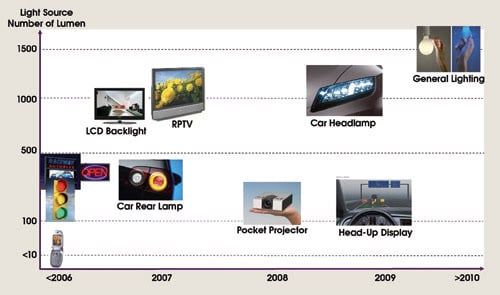Report identifies areas of improvement needed for LEDs to become competitive with traditional lighting.
Anne L. Fischer, Senior Editor
LEDs have proliferated as a result of increased mobile phone sales, but pricing pressure has held revenue growth at only about 8 percent over the past two years, according to a recent report, “LED Manufacturing Technologies,” by Yole Développement of Lyon, France, and by the European Photonics Industry Consortium (EPIC). To increase revenue, the LED market must expand into new application areas, change manufacturing techniques and re-evaluate its business model. Possible applications include automotive lighting, architectural lighting and general illumination, according to Philippe Roussel, senior analyst at Yole. However, the report identifies 10 technology areas that will require significant improvement before they can move into these markets. These include using new substrate materials, temporary bonding and improved binning.

Figure 1. As the number of lumens increases, LEDs will be used in increasing numbers of applications.
An increase in LED performance, which is measured in cost per lumen and in lumens per watt, is necessary and will require new manufacturing techniques. Two technology challenges are to reduce the amount of heat that is generated while simultaneously increasing the light output. Thomas P. Pearsall, secretary general of EPIC, sees light output as the No. 1 problem.
“LED makers can demonstrate relatively high lumens per watt (150 out of a possible 300) but only at very modest currents of a few milliamps. The most important problem to solve right now is getting 150 lumens per watt at full drive current,” he said.
According to Pearsall, the technical advances that will help achieve this include thinner light-emission layers, and laser liftoff and transfer to efficient heat sinking mounts.
The future of LEDs
With the intrinsic efficiency at about 50 percent of its potential, he said that the improvements here will lead to more light and less heat, which will tend to make thermal management less of a priority. Such improvements include thin light-emitting structures, practical and intelligently textured surfaces, and GaN single-crystal substrates.
Once these technology hurdles are overcome, LEDs have the potential to be a competitive alternative to fluorescent lights in the general-illumination and automotive markets. However, before that can be achieved, a new business model is needed. Whereas the incandescent market is buoyed by the fact that 30 percent of the installed base must be replaced every year, the report states that the LED sector will have to continually generate new markets for lighting products with extremely long lifetimes.